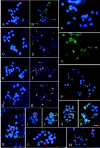Variability of the 5S and 45S rDNA sites in Passiflora L. species with distinct base chromosome numbers
- PMID: 12876193
- PMCID: PMC4243660
- DOI: 10.1093/aob/mcg138
Variability of the 5S and 45S rDNA sites in Passiflora L. species with distinct base chromosome numbers
Abstract
Cytologically, the species of Passiflora with known chromosome number can be divided into four groups: (1) 2n = 12, 24, 36; (2) 2n = 24; (3) 2n = 18, 72; and (4) 2n = 20. The base chromosome number proposed for the genus is x = 6, with x = 9, x = 10 and x = 12 being considered secondary base numbers. In the present study, variability of 5S and 45S rDNA sites was investigated in 20 species of these four groups to check the reliability of this hypothesis. In the group with x = 6, five diploid species (2n = 12) exhibit two 5S rDNA sites and two (P. capsularis, P. morifolia and P. rubra) or four (P. misera 2x and P. tricuspis) 45S rDNA sites. The hexaploid cytotype of P. misera had 12 45S rDNA sites and six 5S rDNA. A tetraploid species, P. suberosa, had ten 45S rDNA sites and four 5S rDNA sites, both in the same chromosomes as the 45S rDNA sites. In the group with x = 9, P. actinia, P. amethystina, P. edmundoi, P. elegans, P. galbana, P. glandulosa and P. mucronata displayed six 45S rDNA sites, whereas P. alata, P. cincinnata, P. edulis f. flavicarpa, P. edulis var. roxo and P. laurifolia had four sites. In this group, all species were diploid (2n = 18) and had only two 5S rDNA sites. Passiflora foetida, the only species with 2n = 20, had six 45S rDNA sites and four 5S rDNA sites. The species with x = 12 (2n = 24), P. haematostigma and P. pentagona, showed four 45S rDNA sites and two 5S rDNA. In general, the number and location of 5S and 45S rDNA sites were consistent with the hypothesis of x = 6 as the probable ancestral genome for the genus, while the groups of species with x = 9, x = 10 and x = 12 were considered to be of tetraploid origin with descending dysploidy and gene silencing of some redundant gene sites, mainly those of 5S rDNA.
Figures


Similar articles
-
Localization of the 5S and 45S rDNA sites and cpDNA sequence analysis in species of the Quadrifaria group of Paspalum (Poaceae, Paniceae).Ann Bot. 2005 Aug;96(2):191-200. doi: 10.1093/aob/mci168. Epub 2005 May 23. Ann Bot. 2005. PMID: 15911540 Free PMC article.
-
Comparative chromosomal localization of 45S and 5S rDNAs and implications for genome evolution in Cucumis.Genome. 2016 Jul;59(7):449-57. doi: 10.1139/gen-2015-0207. Epub 2016 May 11. Genome. 2016. PMID: 27334092
-
Contrasting rDNA evolution in lima bean (Phaseolus lunatus L.) and common bean (P. vulgaris L., Fabaceae).Cytogenet Genome Res. 2011;132(3):212-7. doi: 10.1159/000321677. Epub 2010 Nov 10. Cytogenet Genome Res. 2011. PMID: 21063080
-
Regulation of Pol I-transcribed 45S rDNA and Pol III-transcribed 5S rDNA in Arabidopsis.Plant Cell Physiol. 2012 Feb;53(2):267-76. doi: 10.1093/pcp/pcr177. Epub 2011 Dec 14. Plant Cell Physiol. 2012. PMID: 22173098 Review.
-
Interstitial telomeric sites and Robertsonian translocations in species of Ipheion and Nothoscordum (Amaryllidaceae).Genetica. 2016 Apr;144(2):157-66. doi: 10.1007/s10709-016-9886-1. Epub 2016 Feb 11. Genetica. 2016. PMID: 26869260 Review.
Cited by
-
Localization of the 5S and 45S rDNA sites and cpDNA sequence analysis in species of the Quadrifaria group of Paspalum (Poaceae, Paniceae).Ann Bot. 2005 Aug;96(2):191-200. doi: 10.1093/aob/mci168. Epub 2005 May 23. Ann Bot. 2005. PMID: 15911540 Free PMC article.
-
Uneven Levels of 5S and 45S rDNA Site Number and Loci Variations across Wild Chrysanthemum Accessions.Genes (Basel). 2022 May 17;13(5):894. doi: 10.3390/genes13050894. Genes (Basel). 2022. PMID: 35627279 Free PMC article.
-
Identification of 45S rDNA in Passiflora using low coverage sequencing: analysis of GC content and chromosomal localization.Mol Biol Rep. 2022 Sep;49(9):8555-8566. doi: 10.1007/s11033-022-07686-6. Epub 2022 Aug 23. Mol Biol Rep. 2022. PMID: 35997851
-
Physical mapping of 5S and 18S-5.8S-26S RNA gene families in polyploid series of Cenchrus ciliaris Linnaeus, 1771 (Poaceae).Comp Cytogenet. 2012 Aug 20;6(3):273-86. doi: 10.3897/CompCytogen.v6i3.3380. eCollection 2012. Comp Cytogenet. 2012. PMID: 24260668 Free PMC article.
-
Variation in chromosome numbers, CMA bands and 45S rDNA sites in species of Selaginella (Pteridophyta).Ann Bot. 2005 Jan;95(2):271-6. doi: 10.1093/aob/mci022. Epub 2004 Nov 26. Ann Bot. 2005. PMID: 15567808 Free PMC article.
References
-
- AdamsSP, Leitch IJ, Bennett MD, Chase MW, Leitch AR.2000. Ribosomal DNA evolution and phylogeny in Aloe (Asphodelaceae). American Journal of Botany 87: 1578–1583. - PubMed
-
- BealPR.1973. Cytology of the native Australian and several exotic Passiflora species. 3. Morphology of satellited chromosomes. Queensland Journal of Agricultural and Animal Sciences 30: 19–24.
-
- BennettMD.1995. The development and use of genomic in situ hybridization (GISH) as a new tool in plant cytogenetics. In: Brandham PE, Bennett MD, eds. Kew chromosome conference IV Kew: Royal Botanic Gardens, 167–183.
-
- BerryPE.1987. Chromosome number reports XCV. Taxon 36: 493.
-
- CarvalhoRde, Guerra M.2002. Cytogenetics of Manihot esculenta Crantz (cassava) and eight related species. Hereditas 136: 159–168. - PubMed

